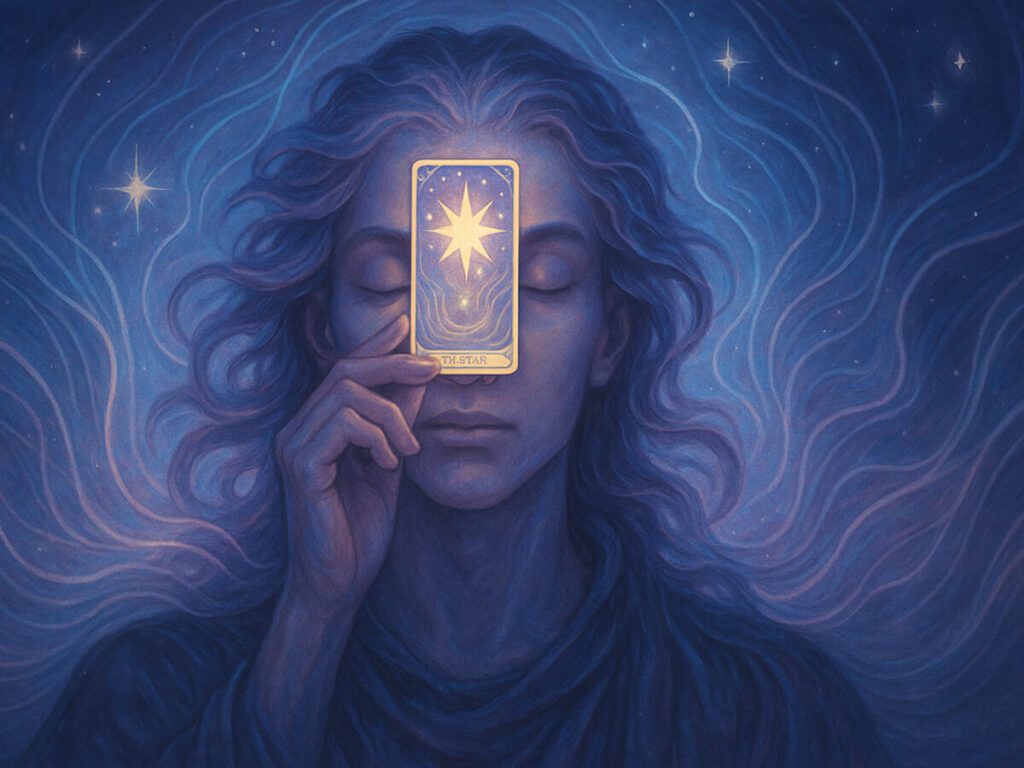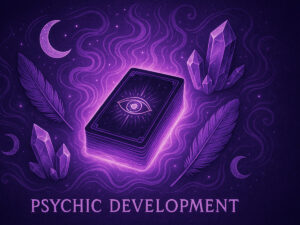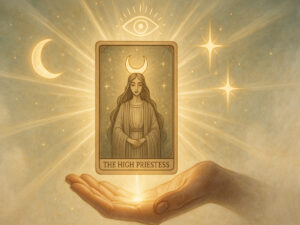An Intuitive Tarot Reading Guide for 2025


Table of Contents
Hello again, my curious friends! Miranda Starr here. You know, after decades spent with these beautiful cards, people often ask me, “Miranda, how do you know what they mean? Do you have every single meaning memorized?” And I usually chuckle! While knowing the traditional meanings is certainly a wonderful foundation, like learning the alphabet before writing poetry, the real magic, the deep connection, comes from somewhere else. It comes from within. That, my dears, is the heart of intuitive tarot reading. It’s less about reciting from a book and more about listening to the whispers of your own tarot inner wisdom, sparked by the incredible tarot card imagery.
I remember when I was first learning, oh goodness, I had my nose buried in guidebooks! I was terrified of getting a meaning “wrong.” Sound familiar? So many beginners feel that pressure. But one day, studying under a wonderfully eccentric reader in Prague, she snatched the book right out of my hands! “Feel it, child!” she insisted. “What does the card say to you?” It was a revelation! A little scary, yes, but freeing. That day, I pulled the Three of Swords. The book said heartbreak, sorrow. But looking at it, really looking, I felt a sense of release, like piercing through an illusion to get to the truth, painful though it might be. That personal tarot interpretation felt more real, more relevant than the generic meaning. That’s the essence of this intuitive tarot guide: learning to trust tarot intuition.
It’s about developing a conversation with your cards, letting them speak directly to your soul. It’s not about abandoning structure entirely, but about weaving your unique perceptions and feelings into the rich tapestry of tarot symbolism intuition. Think of it like jazz music – you learn the scales (traditional meanings), but then you improvise, you feel the rhythm, you add your own flair. This intuitive tarot reading guide is your invitation to start playing your own tarot music in 2025. We’ll explore how to read tarot intuitively, simple tarot intuition exercises, and how to build that all-important tarot reading confidence. Ready to unlock tarot intuition together?
What Exactly Is Intuitive Tarot Reading?
So, we’ve established that intuitive tarot reading isn’t just about memorizing. But what is it, then? Is it some special gift only a few are born with? Not in my experience, dear heart. I truly believe we all have intuition, that tarot inner wisdom, bubbling away inside us. It’s just that some of us haven’t learned how to listen to it yet, or perhaps we’ve been told not to trust it. Intuitive tarot reading is simply the practice of allowing that inner knowing, that gut feeling, to guide your interpretation of the cards, working with the traditional meanings and symbols, not necessarily replacing them entirely.
Think about your psychic senses. We often hear about clairvoyance (clear seeing – getting mental images), clairaudience (clear hearing – hearing words or sounds in your mind), clairsentience (clear feeling – getting gut feelings or emotional responses), and even claircognizance (clear knowing – just knowing something without knowing how). Intuitive tarot reading taps into these senses. When you look at a card, you might see a little scene play out in your mind’s eye (clairvoyance). You might feel a sudden wave of sadness or excitement (clairsentience). You might hear a specific word or phrase pop into your head (clairaudience). Or you might just know that this card, in this context, means something specific for the person you’re reading for, even if it’s slightly different from the book meaning. That’s your intuition speaking the language of tarot!
I remember doing a psychic tarot reading for a young man worried about a career change. He pulled the Eight of Cups. Traditionally, it’s about walking away, abandonment, moving on. And yes, that was part of it. But as I looked at the card, I got this incredibly strong feeling – pure clairsentience – of relief, like a heavy weight lifting off his shoulders. The book didn’t emphasize relief, but my intuition screamed it. So I shared that feeling, “It looks like walking away, yes, but does it also feel like a huge relief?” His eyes widened. That feeling was the key for him; it validated his desire to leave a job that was draining him, even though it looked good on paper. That’s the kind of personal tarot interpretation intuition allows.
It works hand-in-hand with the tarot symbolism intuition naturally picks up on. The symbols, the archetypes, the colors, the numbers – they are the language. Intuition is the translator. Your intuition might draw your eye to a tiny detail in the corner of the tarot card imagery that holds a specific message just for you or your querent. Maybe the way a figure is looking, or a specific color that seems to pulse with energy. It’s about engaging with the cards on a deeper, more energetic level – a form of tarot energy reading.
Now, let’s bust a myth. Some folks think intuitive tarot reading means you just make stuff up based on how you feel. Not at all! It’s a skill you develop, a muscle you strengthen. It requires being present, grounded, and open. It’s about discerning between true intuitive hits and your own projections, fears, or wishful thinking (which takes practice!). It’s an active listening process, tuning into the subtle frequencies of the cards and your own inner knowing. It’s one of the most powerful intuitive tarot techniques for receiving profound tarot spiritual guidance.
Ditching the Book: Why Read Tarot Intuitively?
Now, I know what some of you might be thinking. “But Miranda, the little white book came with the deck! Isn’t it important?” And yes, darling, it is! Especially when you’re starting out, that tarot without guidebook anxiety is real. Those books provide a valuable foundation, a starting point for understanding the traditional energies and intuitive card meanings. But relying only on the book? Oh, that’s like trying to explore a magnificent city using only a tourist map from fifty years ago! You get the main landmarks, sure, but you miss all the hidden alleyways, the vibrant street art, the little cafes where the real life happens. The book gives you the skeleton; intuitive tarot reading fleshes it out with soul.
Why make the leap, though? Why move beyond those comforting, pre-defined meanings? Well, for starters, intuitive tarot reading unlocks a depth of insight that memorization alone just can’t touch. When you read tarot intuitively, you’re not just recalling information; you’re engaging in a dynamic conversation. The cards become mirrors reflecting the querent’s unique energy and situation, not just static symbols. I remember reading for a woman who pulled the Ten of Swords. The book screams rock bottom, betrayal, ruin. And yes, she was going through a tough time. But intuitively? I felt a strange sense of finality, but also… completion. Like this ending, however painful, was absolutely necessary to clear the path for something new. My intuition guided me to focus on the sliver of light on the horizon in the card’s imagery, something the standard meaning often overlooks. That nuance, that personal tarot interpretation, offered her hope and a sense of purpose within the pain, something the stark book meaning might have missed. That’s the power of tarot inner wisdom.
Furthermore, reading intuitively makes your tarot reading skills incredibly flexible. Life isn’t black and white, and neither are the cards! The same card can mean slightly different things depending on the surrounding cards, the question asked, and the querent’s energy. Relying solely on the book can lead to rigid, sometimes contradictory interpretations. Intuition allows you to weave the threads together, to see the story the cards are telling in this specific moment. It helps you understand why The Lovers card might be less about romance and more about a difficult choice in a career reading, or why the Tower might signify a sudden, positive breakthrough for someone feeling stuck. It allows for tarot storytelling that resonates deeply because it’s tailored.
Think about the tarot connection you build. When you move beyond just intellectual understanding and start feeling the cards, engaging your tarot psychic abilities (even if you don’t think you have them – you do!), the relationship transforms. Your deck becomes a trusted friend, a wise confidante. You start recognizing patterns, developing your own associations, your own unique language with the cards. It becomes an embodied knowing, a tarot spiritual guidance system that feels authentic to you. I have decks I’ve worked with for decades, and sometimes a card will whisper something completely unexpected, a meaning forged through years of shared experience. That kind of tarot guidance intuition only comes when you dare to step away from the script and listen deeply. It’s a vital part of tarot intuition development – trusting that connection.
Connecting with Your Cards: The First Steps
Alright, my lovely intuitive explorers, feeling inspired to ditch the book (or at least loosen your grip on it)? Wonderful! But before we dive headfirst into interpreting symbols and trusting those gut feelings, we need to lay the groundwork. You wouldn’t build a house on shaky foundations, would you? Similarly, a strong intuitive tarot practice starts with building a solid, loving tarot connection with your chosen tools – your cards!
First things first: choosing your deck. Oh, the choices these days! It can feel overwhelming, I know. While classic decks like the Rider-Waite-Smith are fantastic for learning traditional symbolism, when focusing on tarot deck choice intuition, the most important factor is resonance. Which deck calls to you? Which tarot card imagery makes your heart sing or sparks your curiosity? Don’t just pick a deck because it’s popular or someone told you to. Browse online, visit a local shop if you can, and really look at the art. Does it feel inviting? Do the characters seem like beings you could have a conversation with? I remember finding my beloved Morgan-Greer deck decades ago; the rich colors and borderless images just pulled me in immediately. It felt like coming home. That feeling, that intuitive pull, is your best guide. Trust it! This initial connect with tarot cards step is crucial.
Once you have your deck, it’s like welcoming a new friend into your home. You want to make it feel welcome and clear out any lingering energy from its journey to you. This is where cleansing comes in. There are countless ways to do this, so again, trust your intuition! You could pass the deck through sage or palo santo smoke, leave it out under the moonlight (especially the full moon!), knock on it firmly three times to disperse old energy, or place a clear quartz crystal on top of it overnight. I personally love shuffling the deck thoroughly while visualizing any old energy dissolving and my own positive intention infusing the cards. It’s less about rigid ritual and more about setting the intention to make the deck yours.
After cleansing, spend time bonding. This isn’t a one-time thing, but an ongoing process. Handle your cards often! Shuffle them daily, even if you’re not doing a reading. Look through the images one by one. Sleep with the deck under your pillow (maybe wrapped in silk). Carry a specific card with you for a day and see how its energy interacts with your experiences. This helps you absorb the tarot card imagery on a subconscious level and strengthens your personal tarot connection. It’s like getting to know a friend’s quirks and personality.
Creating a dedicated space for your readings, even a small one, can also significantly enhance your intuitive tarot practice. It doesn’t need to be elaborate – a corner of a room, a small table, even just a special cloth you lay out. Make it feel sacred to you. Maybe add a candle, a crystal, or an object that represents your intention. This physical space helps signal to your mind and spirit that it’s time to tune in, to quiet the external noise and listen to your tarot inner wisdom. It creates an atmosphere conducive to tarot energy reading.
Finally, before you even shuffle for a reading, take a moment to set your intention. What guidance are you seeking? Get clear on your question (as we discussed before!). Hold the deck, take a few deep breaths, and mentally (or aloud) state your intention or ask your question. Ask for clear, compassionate guidance for the highest good. This simple act focuses your energy and invites your intuition to step forward. These initial steps – choosing with heart, cleansing, bonding, creating space, and setting intention – are the bedrock upon which a truly insightful and intuitive tarot reading practice is built.
Simple Techniques to Develop Tarot Intuition
Alright, we’ve connected with our cards, set our space… now for the juicy part! How do we actually start flexing that intuitive muscle? Like any muscle, tarot intuition development takes practice, patience, and a playful spirit. It’s not about forcing it, but gently creating opportunities for your tarot inner wisdom to speak up and be heard. Luckily, there are some wonderfully simple, yet profound, tarot intuition exercises you can weave into your daily life.
One of my absolute favorite starting points, especially for tarot beginners intuition, is the daily tarot draw intuition practice. Just one card! Before you look up any meanings, simply sit with the card for a few moments. How does it make you feel? Happy, sad, anxious, calm? What thoughts or images pop into your head? What part of the tarot card imagery catches your eye first? Maybe jot down these initial impressions – your raw, unfiltered intuitive hits – in a journal. Then, if you like, you can look up the traditional meaning and see how your intuition aligns, differs, or adds a unique layer. I did this for years (still do, sometimes!). I remember pulling the Queen of Swords one morning. My immediate feeling was sharpness, clarity, but also a touch of loneliness. The book emphasized intelligence and independence. My intuitive hit added that emotional nuance of potential isolation that comes with such sharp boundaries. That little insight shifted how I approached a conversation later that day.
This leads beautifully into tarot journaling intuition. Oh, the power of writing things down! Keep a dedicated notebook for your tarot journey. Record your daily draws, your intuitive flashes, the questions you ask, the spreads you do, and how the readings actually play out over time. This isn’t just about logging data; it’s about recognizing patterns. You’ll start to see your specific intuitive language emerge. Maybe the Knight of Cups consistently shows up for you when a creative opportunity is brewing, even if the book meaning is slightly different. Your journal becomes your personal tarot guidebook, written by your own intuition! It’s a fantastic way to build tarot reading confidence as you see your intuitive accuracy grow.
Meditation tarot intuition is another powerful technique. You can simply meditate while holding your deck or a specific card, asking for insights. Or try a tarot visualization: pick a card, gaze at it softly, then close your eyes and imagine stepping into the scene. What does it feel like? Who do you meet? What messages do you receive? I often guide clients to visualize walking the path in the Six of Swords or standing before the figures in the Hierophant. This active engagement bypasses the analytical mind and speaks directly to your subconscious, where intuition resides. It’s a beautiful way to connect with tarot cards on a deeper level.
Don’t underestimate the power of simply looking. Choose a card and just observe it for five minutes. Let your eyes wander over the details without trying to interpret anything. Notice the colors, the shapes, the expressions, the background elements. This practice trains your observational skills, which are crucial for picking up subtle intuitive cues within the tarot card imagery. You might notice a tiny detail you’ve never seen before that suddenly sparks an insight. It’s about cultivating presence, a key ingredient for unlocking tarot intuition.
And remember those psychic senses we talked about? You can do little exercises to strengthen them. Try guessing who’s calling before looking at your phone (claircognizance). Pay attention to the ‘vibe’ you get when meeting someone new (clairsentience). Notice any recurring mental images or ‘daydreams’ (clairvoyance). These everyday practices help tune your intuitive antennae, making you more receptive during psychic tarot reading sessions. It’s all part of the intuitive tarot practice, integrating it into your life, not just keeping it for the reading table.
Interpreting Imagery & Symbols Intuitively
Alright, my intuitive apprentices, let’s zoom in a little closer. We’ve talked about connecting with the cards and simple exercises, but how do we actually interpret what we’re seeing and feeling when we look at that intricate tarot card imagery? This is where the real art of intuitive tarot reading comes alive! It’s about learning to see beyond the surface, beyond just the standard tarot symbolism intuition often relies on initially, and engaging in a deeper dialogue with the pictures themselves.
Think of each tarot card as a tiny, potent world packed with information. Traditional meanings give us the general climate of that world, but our intuition helps us notice the specific weather patterns, the unique flora and fauna, the hidden pathways. Start by paying attention to the obvious, then let your focus soften. What colors dominate the card, and how do those colors make you feel? Bright yellows might spark feelings of optimism and clarity (like in The Sun), while deep blues could evoke introspection or sadness (perhaps in the Five of Cups). Are there significant numbers? Four Wands might speak of stability and celebration, while five Swords could suggest conflict and loss. How are the figures positioned? Are they facing towards or away from each other? Are they active or passive? What are they holding? Every element is a potential clue, a breadcrumb dropped by your intuition.
I encourage you to practice tarot storytelling. Look at a card, or even a sequence of cards, and ask: What story is unfolding here? Forget the keywords for a moment. Just describe what you see as if you were telling a tale. “There’s a figure standing on a cliff, looking out at the sea. They seem hesitant, but also hopeful. There are ships sailing away…” This narrative approach often unlocks intuitive insights tarot offers more readily than trying to force-fit a memorized meaning. I once read for someone who pulled the Page of Cups. Instead of just saying “creative offer” or “emotional message,” I described the scene: “Look how gently he holds that cup, like it’s precious. And there’s a fish popping out! It feels like an unexpected, perhaps slightly quirky, emotional surprise is coming your way, something you need to handle with care.” That story resonated far more than the keywords alone.
Don’t discount your personal associations either! This is a big part of personal tarot interpretation. Does the landscape in the Ten of Pentacles remind you of your grandmother’s garden, bringing feelings of security and nostalgia? Does the figure in the Knight of Swords feel like an ex-boyfriend, triggering caution? These personal connections aren’t random; they are your subconscious linking the card’s energy to your own lived experience. Acknowledge them! They add layers of meaning that are uniquely relevant to you or the person you’re reading for. Of course, discernment is key – ensure it’s a genuine intuitive link, not just projection, but don’t dismiss these personal sparks.
And perhaps most importantly: trust the tarot feeling cards evoke. How does the overall energy of the card land in your body? Does it feel expansive or constricted? Heavy or light? Agitated or calm? This is clairsentience at work, your body’s wisdom responding to the card’s vibration. I remember pulling The Devil card for myself once. Intellectually, I knew it meant bondage, addiction, materialism. But the feeling? It was less scary and more… seductive. It felt like the allure of staying in a comfortable but limiting situation.
That feeling guided my interpretation towards understanding the temptation of staying stuck, rather than just the state of being stuck. Learning to identify and trust these subtle (and sometimes not-so-subtle) feelings is a cornerstone of tarot intuition development. It moves your reading from the head to the heart and gut, where true wisdom resides.
Blending Intuition with Traditional Meanings
Now, my lovely seekers, as we delve deeper into this intuitive tarot reading guide, you might be wondering if it’s a complete break from everything you’ve learned about traditional card meanings. Do we just toss the guidebooks into the bonfire and rely solely on vibes? Not necessarily! While I champion trusting tarot intuition, I also believe there’s immense value in understanding the traditional foundations. The debate of intuitive vs traditional tarot often presents a false dichotomy; the most powerful readings often come from blending both.
Think of traditional meanings – the ones you find in books or learn in courses – as the sturdy skeleton of your reading. They provide structure, context, and a shared language that has evolved over centuries. Understanding that the Suit of Swords often relates to the mind and conflict, or that Pentacles connect to the material world, gives you a crucial starting point. It prevents your readings from becoming completely untethered or purely subjective. I always encourage beginners to familiarize themselves with these core tarot card meanings intuition can then build upon. It’s like learning musical scales before you start improvising jazz; the structure supports the freedom.
Where intuition comes in is adding the flesh, the blood, the unique spirit to that skeleton. Your intuition takes the general meaning and tailors it exquisitely to the specific situation and energy present. Let’s revisit the Ten of Swords. Traditionally: rock bottom, ruin, betrayal. A purely analytic tarot reading might stop there, delivering a rather bleak message. But your intuition might sense, as in my earlier example, a necessary ending, a release, or even a specific detail about how that ending feels. Maybe you pull the Four of Cups (apathy, boredom, missed opportunities) alongside a card suggesting career. The traditional meaning is clear. But your intuition might whisper, “It’s not just boredom; it’s boredom stemming from undervaluing their creative talents at work.” See how intuition adds that specific, actionable nuance? It elevates the interpretation from generic to deeply personal, enhancing your tarot interpretation skills.
So, how do you know when to lean more on structure versus flow? This comes with practice and developing tarot reading confidence. Often, the traditional meaning provides the theme, and intuition provides the specific details or emotional tone. If you pull a card and get an immediate, strong intuitive hit that feels clear and resonant, trust it! Even if it seems slightly different from the book. If you pull a card and feel completely blank or confused, it’s perfectly okay to lean on the traditional meaning as a starting point. Ask yourself: “Okay, the book says this means X. How might that apply here? What does my intuition add to that?” Sometimes, the traditional meaning itself will spark an intuitive connection you hadn’t noticed.
Ultimately, this blend helps you discover your unique tarot reading styles. Some readers are naturally more analytical, using intuition to refine structured interpretations. Others are highly psychic, using traditional meanings only as occasional reference points. Most of us fall somewhere in between, developing a style that feels authentic. Are you a storyteller, weaving narratives from the cards? Are you an energy worker, focusing on the vibrational feel? Are you a practical advisor, using intuition to ground insights in actionable steps? There’s no single “right” way. Your style will evolve as your tarot intuition development progresses.
Don’t see intuitive vs traditional tarot as a battle. See it as a dance. Sometimes structure leads, sometimes intuition leads. The goal is a harmonious partnership that allows for the richest, most insightful tarot guidance intuition and knowledge can offer together. Embrace the structure, honor the tradition, but always, always leave ample space for the magic of your own inner knowing to shine through.
Trusting Your Inner Wisdom in Readings
Ah, my friends, we arrive at the heart of the matter, the cornerstone of any truly intuitive tarot practice: learning to trust that tarot inner wisdom. It sounds simple, doesn’t it? Just trust your gut! But oh, how challenging it can be in practice. That pesky inner critic, the fear of being wrong, the societal conditioning that tells us to rely only on logic – they can all shout louder than the subtle whispers of intuition. Building tarot reading confidence is perhaps the most crucial, and sometimes most difficult, part of the tarot intuition development journey.
One of the biggest hurdles is self-doubt. “Was that really intuition, or did I just imagine it?” “What if I tell the querent the wrong thing?” “Maybe I should just stick to the book.” Sound familiar? These thoughts are completely normal, especially when you’re starting to read tarot intuitively. The key is not to let them paralyze you. Acknowledge the fear, thank your mind for trying to protect you, and gently choose to lean into the intuitive nudge anyway. I remember early on, I’d get flashes of insight during readings that seemed totally unrelated to the cards. I’d hesitate, thinking, “That’s silly, where did that come from?” But more often than not, when I found the courage to share it tentatively – “This might sound strange, but I keep getting a picture of a blue bicycle… does that mean anything to you?” – it would unlock something profound for the querent. Each time you take that leap of faith and find your intuition was spot on (or even just offered a valuable perspective), you build a little more trust.
Learning to discern between genuine intuition and mental chatter is also vital. Intuition often feels calm, clear, and neutral, even if the message itself is challenging. It arrives as a quiet knowing, a gut feeling, a sudden image, or a sense of resonance. Mental chatter, on the other hand, tends to be loud, anxious, repetitive, emotionally charged, or heavily influenced by your own desires and fears (ego). If a thought feels pushy, judgmental, or rooted in wishful thinking (“This must mean I’m getting that promotion!”), pause and question it. Is it coming from a place of clarity or a place of ego? Meditation tarot intuition practices can be incredibly helpful here, as they teach you to observe your thoughts without getting swept away by them, making it easier to recognize the quieter voice of tarot inner wisdom.
Practice, practice, practice is the mantra for building tarot reading confidence. Read for yourself regularly, using the journaling techniques we discussed to track your hits and misses without judgment. Offer practice readings to trusted friends who understand you’re learning (and won’t put pressure on you). The more you engage with the process, the more familiar you’ll become with how your specific intuition communicates. Maybe you get tingles when a message is significant, or perhaps certain cards consistently trigger specific feelings for you. Pay attention to these personal cues! They are part of your unique intuitive language, crucial for tarot self discovery.
And please, be kind to yourself! Developing tarot psychic abilities and intuitive skills takes time. You will have readings where you feel unsure or disconnected. That’s okay! It doesn’t mean you’re failing. It just means you’re human. On those days, lean more on the traditional meanings, keep it simple, or simply take a break. Grounding and self-care are essential for maintaining clear intuitive insights tarot can offer. If you’re stressed, tired, or emotionally overwhelmed, your intuitive channel is likely to be fuzzy. Take a walk in nature, have a bath, meditate – do whatever helps you return to a state of centeredness before you try to read.
Ultimately, trusting your intuition in tarot is an act of trusting yourself. It’s reclaiming a part of your innate wisdom that society may have encouraged you to ignore. It’s about believing that you have the capacity to connect with deeper truths, both for yourself and for others. As you continue your intuitive tarot practice, celebrate the small wins, learn from the uncertainties, and keep listening to those gentle whispers. That trust is the magic key that unlocks the full, transformative power of the cards.
Embracing Your Inner Tarot Oracle
And so, my dear intuitive souls, our journey through this intuitive tarot reading guide draws to a close for now. We’ve explored what it means to read tarot intuitively, moving beyond the book to engage with our tarot inner wisdom and the rich tarot card imagery. We’ve discussed the importance of building a tarot connection with your cards, simple tarot intuition exercises like daily draws and journaling, and the art of interpreting symbols through tarot storytelling and tarot feeling cards. We even touched upon the beautiful dance between intuitive vs traditional tarot and the vital importance of learning to trust tarot intuition.
My deepest hope is that you feel inspired and empowered to embark on, or deepen, your own intuitive tarot practice. Remember, this isn’t about becoming someone else; it’s about becoming more fully yourself. It’s about reclaiming your innate ability to perceive subtle energies and access profound tarot spiritual guidance. Whether you’re a complete beginner feeling that first spark of tarot beginners intuition or a seasoned reader looking to deepen your skills, the path of tarot intuition development is always open.
Don’t strive for perfection. Strive for connection. Be patient, be curious, be playful. Let your deck become a trusted friend, a mirror reflecting your own magnificent inner landscape. Use the intuitive tarot techniques we discussed not as rigid rules, but as invitations to explore. What intuitive messages are waiting for you just beneath the surface? What tarot self discovery awaits when you truly start to listen?
I encourage you to take one small step today. Perhaps pull a card and just feel it. Maybe start that tarot journaling intuition practice. Or simply hold your deck and set the intention to be more open to your intuitive insights tarot offers. The journey of a thousand miles begins with a single step, and the journey to becoming an intuitive reader begins with the simple choice to trust yourself.
Frequently Asked Questions
Do I need to be psychic to read tarot intuitively?
Oh, that’s a common worry! But no, my dear, you don’t need to have dramatic visions or hear voices from the beyond to practice intuitive tarot reading. We all have intuition – that gut feeling, that inner knowing. Psychic tarot reading might involve more pronounced psychic senses, but intuitive tarot reading is simply about learning to listen to your own subtle perceptions, feelings, and the tarot inner wisdom sparked by the cards. It’s a skill you can develop tarot intuition for, not necessarily an innate gift only some possess.
Can my intuition be wrong when reading tarot?
Can our interpretation be influenced by our own stuff? Absolutely! That’s why discernment is key. Sometimes what feels like intuition might be wishful thinking, fear, or projection. Part of tarot intuition development is learning to recognize the difference. True intuition often feels calm and neutral, even if the message is difficult, while ego-driven thoughts can feel loud or anxious. Don’t fear being “wrong.” See it as part of the learning process. Keep practicing, journal your readings (tarot journaling intuition), and notice the patterns. Your accuracy and tarot reading confidence will grow over time.
Is it better to read intuitively or stick to the traditional meanings?
As we discussed, I don’t see it as an either/or! The intuitive vs traditional tarot debate is often misleading. Think of it as a blend. Traditional meanings provide a valuable foundation and shared language. Intuition adds personal depth, nuance, and relevance to the specific reading. The most powerful readings often weave both together. Use traditional meanings as a starting point, especially if you feel stuck, but always allow space for your personal tarot interpretation and intuitive hits to enrich the reading. Finding your unique balance is part of discovering your tarot reading styles.
What’s the best tarot deck for intuitive reading?
While decks rich in tarot card imagery and symbolism (like the Rider-Waite-Smith or Thoth) are often recommended because they offer lots to visually connect with, the best deck is truly the one that speaks to your intuition. When choosing, focus on tarot deck choice intuition. Which artwork resonates with you? Which deck feels good in your hands? Which one sparks your curiosity and makes you want to connect with tarot cards? Trust that gut feeling. A deck you feel personally drawn to will naturally make it easier to unlock tarot intuition.
How long does it take to become good at intuitive tarot reading?
Oh, honey, it’s a lifelong journey, not a destination with a finish line! Some people connect very quickly, while others take more time. Be patient and compassionate with yourself. Consistent intuitive tarot practice, even just 5-10 minutes a day with a daily tarot draw intuition exercise, makes a huge difference. Focus on building that tarot connection and learning your own intuitive language, rather than worrying about how long it takes. Enjoy the process of tarot self discovery!






